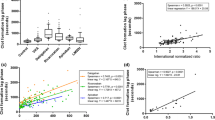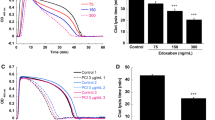Abstract
Acetaldehyde (AcH) at preincubationconcentrations of 447, 89.4, and 17.9 mM potentiates theeffects of heparin on the clotting time of plasma. Whilecontrol plasma clotted in the range of 12.6 ± 0.1 to 13.8 ± 0.1 sec, and heparin-treatedplasma clotted in a range from 131.5 ± 2.5 to168.2 ± 1.2 sec, heparin that was preincubated atroom temperature for 30 min with 89.4 or 447 mM AcH didnot clot plasma in 300 sec. Heparin exposed to 17.9 mMAcH clotted plasma in 193 ± 1.1 sec. Ethanol ata 404 mM concentration also prolonged the clotting timeof heparin-treated plasma >300 sec, while 202 mM ethanol prolonged the clotting time ofheparin-treated plasma from 149.0 ± 2.0 sec to219.5 ± 1.7 sec. It is suggested that AcH altersthe tertiary structure of heparin by adduct formation,possibly by formation of cyclic acetals with iduronicand glucuronic acids, thereby more readily affectingbinding of the glycosaminoglycan to antithrombin IIIand/or thrombin, prolonging clotting time. Ethanol, which does not react covalently with heparin,might affect its conformation as a consequence of anorganic solvent effect. Protamine sulfate prolonged theclotting time of plasma from 13.6 ± 0.1 sec to 17.9 ± 0.2 sec. Protaminesulfate-treated heparin clotted plasma in 21.0 ±0.4 sec relative to heparin-treated plasma (160.4± 1.7 sec). In subsequent experiments,AcH-treated protamine sulfate extended the clotting time of protamine sulfate from17.9 ± 0 sec to 33.7 ± 0.6 sec. Prioraddition of protamine sulfate to AcH- heparin mixturesor heparin to protamine sulfate-AcH mixtures beforeaddition to plasma resulted in clotting times of 22.0± 0.4 sec and 24.1 ± 0.5 sec,respectively, relative to control clotting times of162.3 ± 2.6 sec for plasma-heparin mixtures.These results confirm both the reduction in coagulation time ofheparin-treated plasma by protamine sulfate and theprolongation of clotting time of plasma by protaminesulfate. Furthermore, and importantly, they indicatethat acetaldehyde-treated protamine sulfate is a more effectiveanticoagulant than protamine sulfate. It is suggestedthat reversible adduct formation between acetaldehyde,heparin, and protamine sulfate may occur as a meansexplaining the essentially identical coagulation time ofthese mixtures when added to plasma regardless of theorder of premixing. Ethanol (404 mM) did not influenceprotamine sulfate effects. Lastly, the potentiation of the anticoagulant function of heparin byacetaldehyde suggests that a structural modification ofthe glycosaminoglycan may occur in alcoholics.
Similar content being viewed by others
REFERENCES
Crabb DW, Lumeng L: Alcoholic liver disease. In WN Kelly (ed). Textbook of Internal Medicine. Philadelphia, Lippincott, 1989, pp 592–602
Podolsky DK, Isselbacher KJ: Cirrhosis. In E Braunwald, KJ Isselbacher, RG Petersdorf, JD Wilson, JB Martin, AS Sauci (eds). Harrison's Principles of Internal Medicine, 12th ed. New York, McGraw-Hill, 1991, pp 1341–1351
Basista MH, Joseph A, Smolen S, Koterba A, Brecher AS: Acetaldehyde alters coagulation function. Dig Dis Sci 39:2421–2425, 1994
Brecher AS, Koterba AP, Basista MH: Coagulation protein function. III. Effect of acetaldehyde upon the activation of prothrombin. Alcohol 13:423–429, 1996
Brecher AS, Koterba AP, Basista MH: Coagulation protein function. IV. Effect of acetaldehyde upon factor X and factor Xa, the proteins at the gateway to the common coagulation pathway. Alcohol 13:539–545, 1996
Haider SK, Kleshinski J, Brecher A, Basista MH: The direct effect of acetaldehyde on the function of clotting factors VII, IX, and XI. Abstracts. American Association for the Study of Liver Disease, Chicago, Illinois, November 8–12, 1996
Gavrilis P, Lerner RG, Goldstein R: Plasma factor Xainhibitory activity in alcoholic liver disease and the effect of heparin. Thromb Res 4:335–343, 1974
Bauer KA, Rosenberg RD: Control of coagulation reactions. In E Beutler, MA Lichtman, BS Coller, TJ Kipps (eds). Williams' Hematology, 5th ed. New York, McGraw-Hill, 1995, pp 1239–1252
Majerus PW, Broze GJ Jr, Miletich JP, Tollefsen DM: Anticoagulant, thrombolytic, and antiplatelet drugs. In A Goodman, TW Gilman, AS Nies, P Taylor (eds). Goodman and Gilman' s The Pharmacological Basis of Therapeutics, 8th ed. New York, Pergamon Press, 1990, pp 1311–1331
Travis J, Salvesen GS: Human plasma proteinase inhibitors. In EE Snell (ed). Annu Rev Biochem 52: 655–709, 1983
Rosenberg RD: The role of heparin and heparin-like mole-cules in thrombosis and atherosclerosis. Fed Proc 44:404–409, 1985
Skinner R, Abrahams JP, Whisstock JC, Lesk AM, Carrell RW, Wardell MR: The 2.6 Å structure of antithrombin indicates a conformational change at the heparin binding site. J Mol Biol 266:601–609, 1997
Brecher AS: Clotting system. In PJ Delves, I Roitt (eds). Encyclopedia of Immunology, 2nd ed. London, Academic Press, 1997 ( in press)
Bordalo O, Batista A, Geraldes J, Neto F, Mascarenhas F, Leitao N, Noronha M, Lamy J, Silva PE: Clinical correlations in alcoholic patients without manifest cirrhosis. Am J Gastroenterol 61:371–378, 1974
Fraenkel-Conrat H, Brandon BA, Olcott HS: The reaction of formaldehyde with proteins. IV. Participation of indole groups. Gramidicin J Biol Chem 168:99–118, 1947
Fraenkel-Conrat H, Olcott HS: The reaction of formaldehyde with proteins. V. Cross-linking between amino and primary amide or guanidyl groups. J Am Chem Soc 70:2673–2684, 1948
Fraenkel-Conrat H, Olcott HS: Reaction of formaldehyde with proteins. VI. Cross-linking of amino groups with phenol, imidazole, or indole groups. J Biol Chem 174:827–843, 1948
Ratner S, Clarke HT: The action of formaldehyde upon cysteine. J Am Chem Soc 59:200–206, 1937
Henriques V, Sorensen SPL: The quantitative estimation of amino acids, polypeptides and hippuric acid in urine by titration with formaldehyde. II. Z Physiol Chem 64:120–143, 1909
Salaspuro M: Epidemiological aspects of alcohol and alcoholic liver disease, ethanol metabolism, and pathogenesis of alcoholic liver injury. In N McIntyre, JP Benhamov, J Bircher, M Rizzetto, J Rodes (eds). Oxford Textbook of Clinical Hepatology. Oxford, Oxford University Press, 1991, pp 791–810
Hatake K, Taniguchi T, Ouchi H, Sakaki N, Hishida S, Ijiri I: Possible involvement of kinins in cardiovascular changes after alcohol intake. Pharmacol Biochem Behav 35:437–442, 1990
Hernande z-Munoz R, Ma X, Baraona E, Lieber CS: Method of acetaldehyde measurement with minimal artifactual formation in red blood cells and plasma of actively drinking subjects with alcoholism. J Lab Clin Med 120:35–41, 1992
Wickramasinghe SN, Thomas S, Hasan R: Reaction of 14Cacetaldehyde with whole blood in vitro: Further evidence for the formation of unstable complexes with plasma proteins and red cells. Alcohol Alcohol 29:51–57, 1994
Lin RC, Shahidi S, Kelly TJ, Lumeng C, Lumeng L: Measure-ment of hemoglobin-acetaldehyde adduct in alcoholic patients. Alcohol Clin Exp Res 17:674–699, 1993
Nicholls RM, Fowles LF, Worrall S, deJersey J, Wilce PA: Distribution and turnover of acetaldehyde-modified proteins in liver and blood of ethanol-fed rats. Alcohol Alcohol 29:149–157, 1994
Tuma DJ, Klassen LW: Immune responses to ace taldehyde-protein adducts: Role in alcoholic liver disease. Gastroenterology 103:1969–1973, 1992
Wehr H, Rodo M, Lieber CS, Baraona E: Acetaldehyde adducts and autoantibodies against VLDL and LDL in alcoholics. J Lipid Res 34:1237–1244, 1993
Rights and permissions
About this article
Cite this article
Brecher, A.S., Hellman, K. & Basista, M.H. Coagulation Protein Function VI (Augmentation of Anticoagulant Function by Acetaldehyde-Treated Heparin). Dig Dis Sci 44, 1349–1355 (1999). https://doi.org/10.1023/A:1026635331519
Issue Date:
DOI: https://doi.org/10.1023/A:1026635331519




